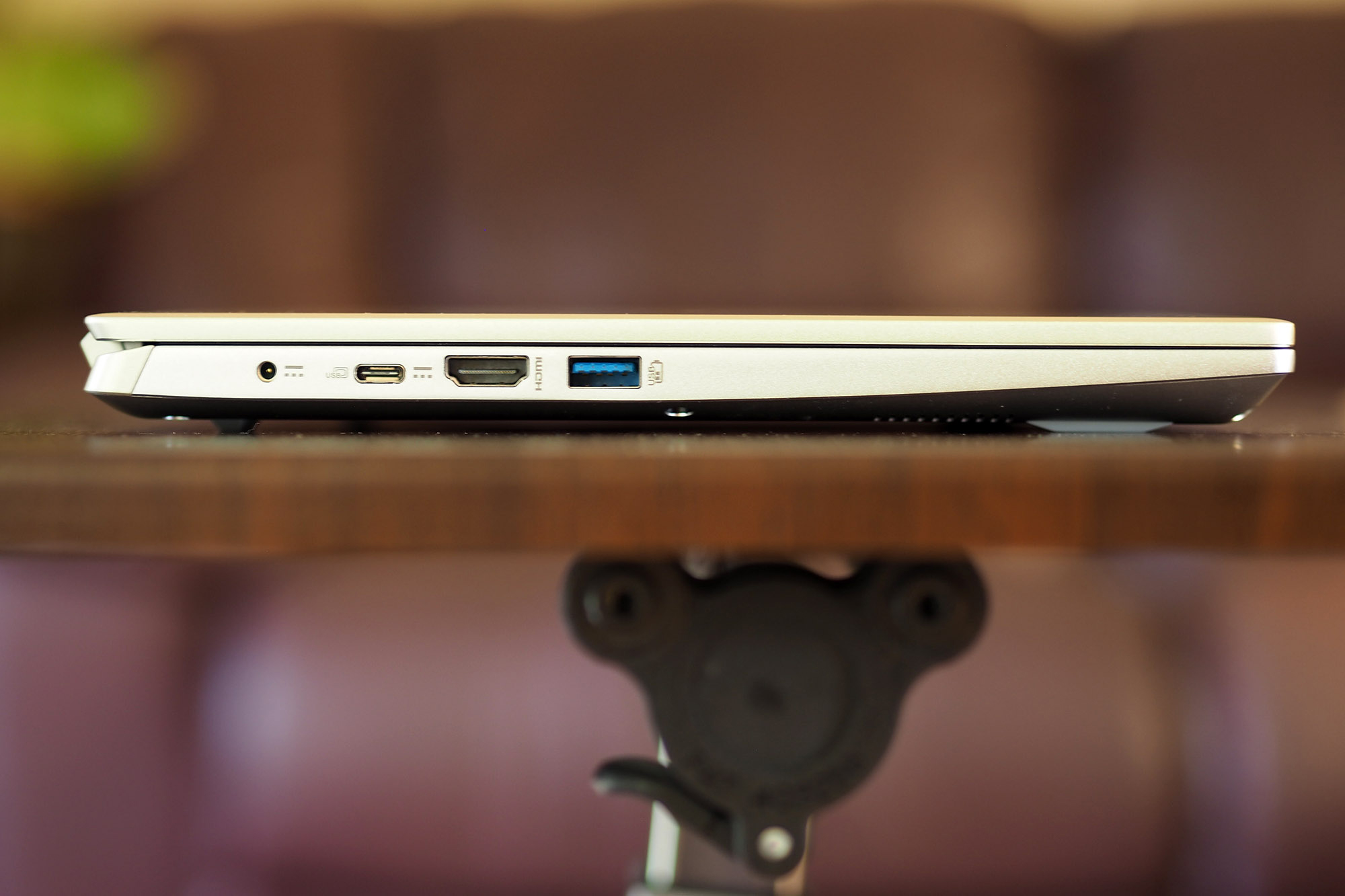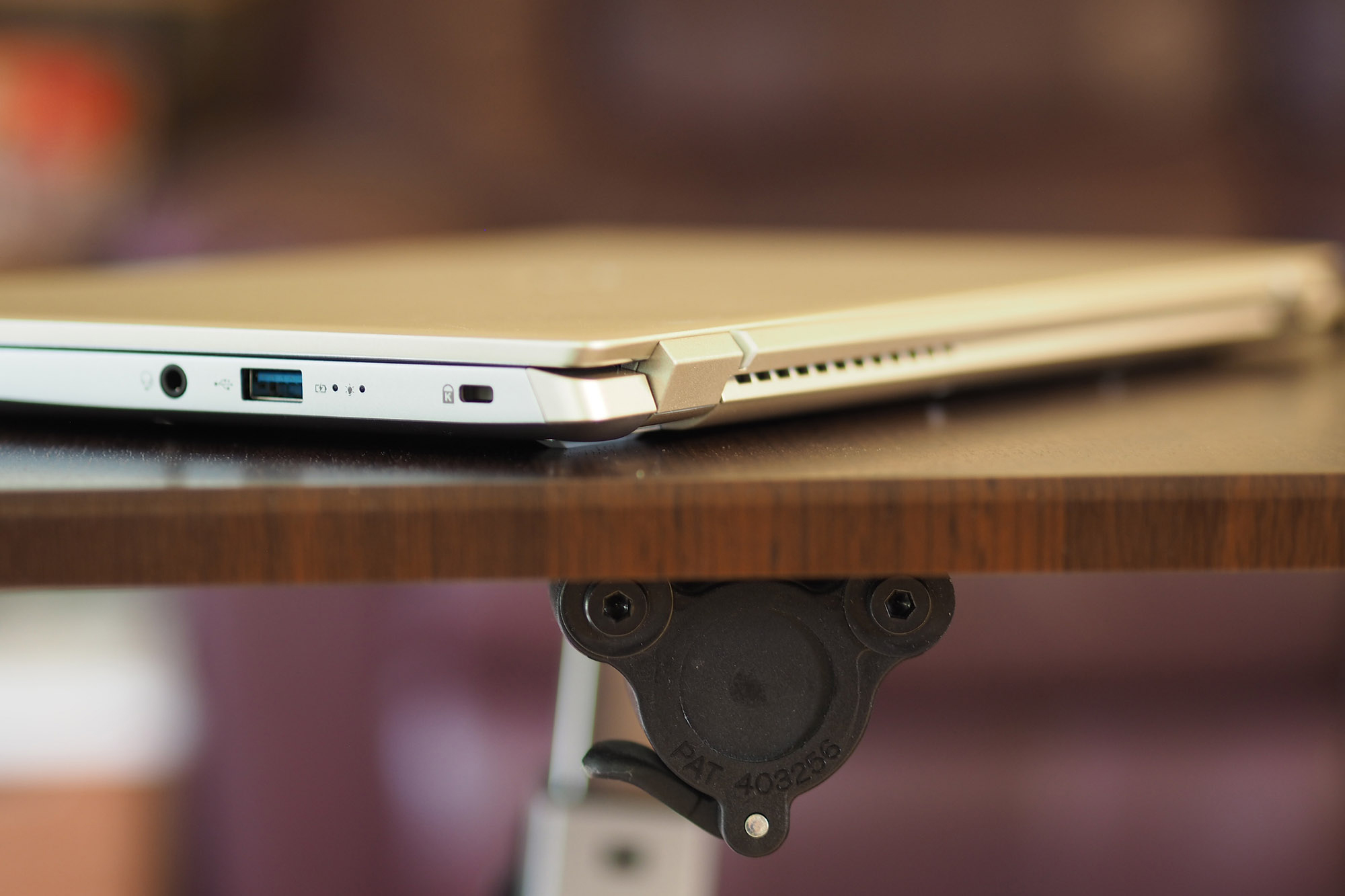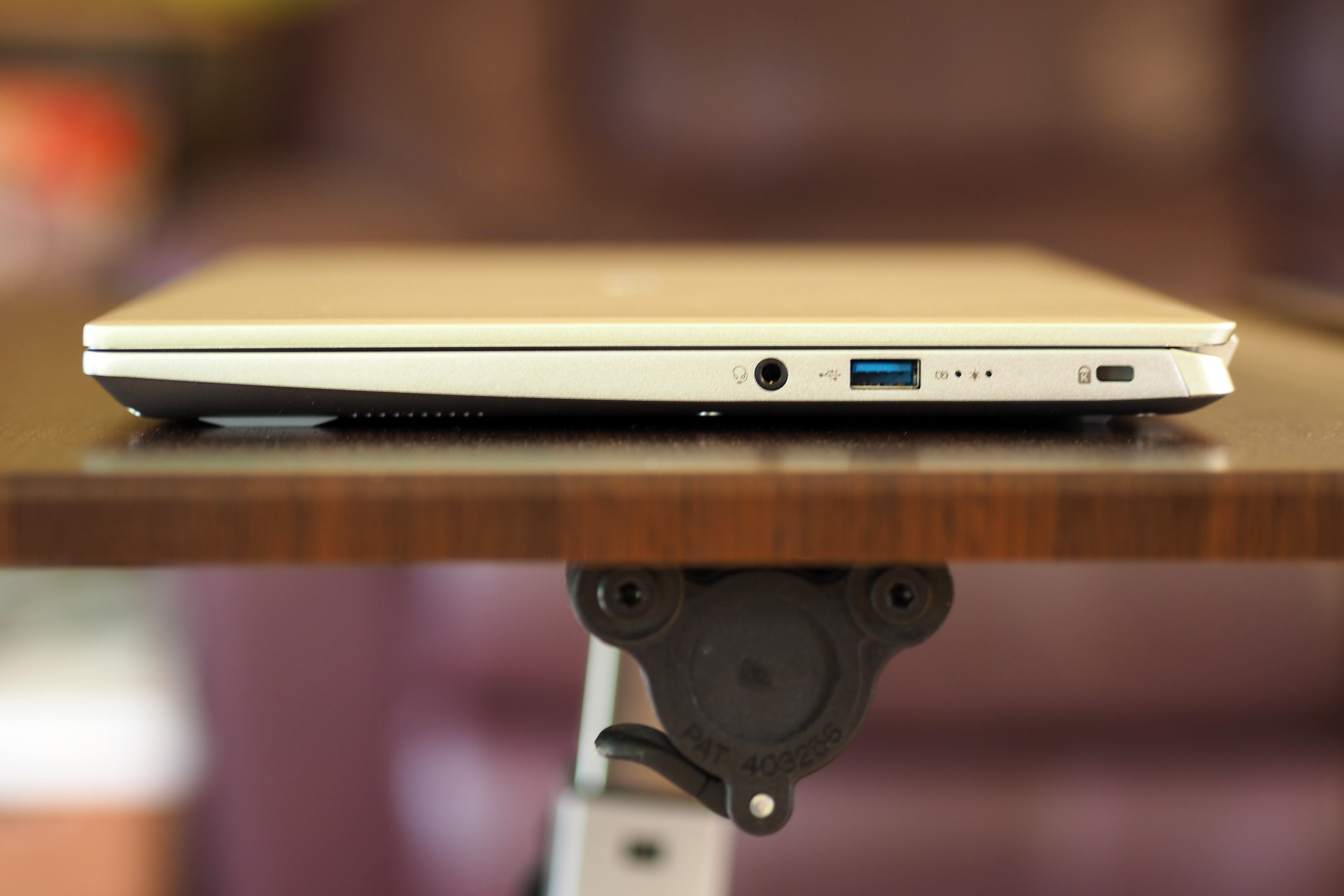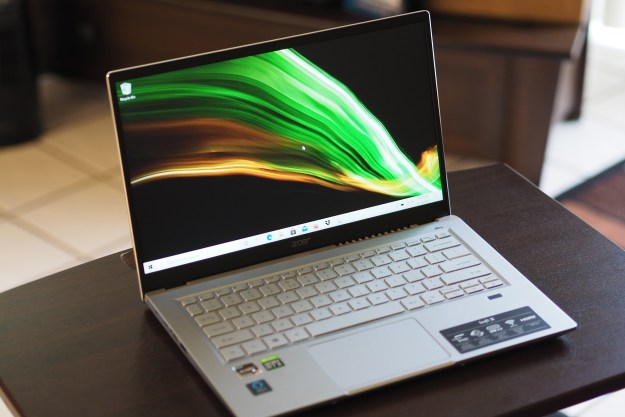
“The Acer Swift X is a performance-first laptop that plenty of students and creatives will appreciate.”
- Outstanding performance
- Very good battery life
- Excellent keyboard and touchpad
- Solid entry-level gaming
- Thin-and-light frame given the power inside
- Build quality could be better
- Display is inadequate for the target market
Creative professionals need two things in a great laptop more than anything else. First, they need power, and lots of it — preferably, both a fast CPU and a fast GPU. Second, they need a display with wide and accurate colors and plenty of contrast and brightness. Acer’s Swift X is aimed at those creators, despite offering configurations as low as $1,100. Is it possible at that price?
The Acer Swift X’s AMD Ryzen 7 5800U, RTX 3050 Ti, and 14-inch display certainly seem up to the task. After putting it through its paces, the Swift X is far from a perfect machine — but its fantastic performance and good value make it a standout among its competitors.
Design
The Acer Swift X features an all-aluminum chassis that was a little bendy in the lid and suffered from a bit of keyboard flex. It’s nothing egregious. but Asus, Dell, and HP laptops tend to have stiffer builds. The MSI Prestige 14 Evo, Dell XPS 13, and HP Spectre x360 14 are three laptops that feel more solid in hand. The Swift X’s hinge is capable, almost allowing for one-handed opening and keeping the display firmly in place while you’re working. If the Swift X were more expensive, I’d have more of a problem with the build quality. We’re just at the edge of premium for a well-configured machine, though, and so I’m willing to overlook a little flexibility.
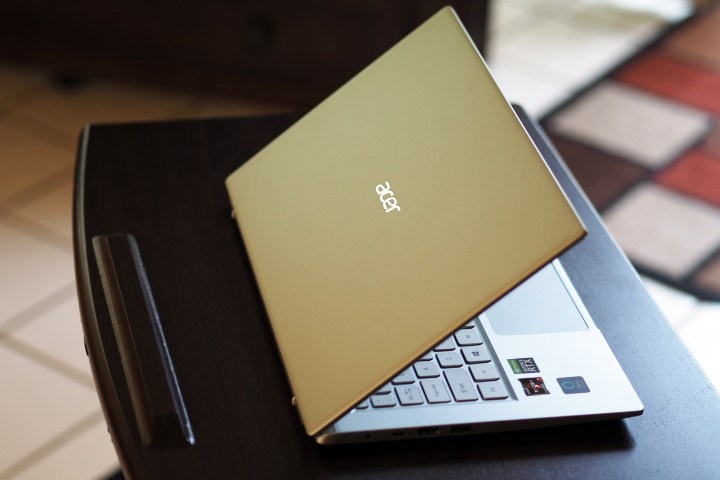
Aesthetically, the Swift X is a conservative laptop that incorporates just a few angles, including along the back of the chassis, to add some distinction. It’s available in three creatively titled colors, Safari Gold (my review unit), Steam Blue, and Prodigy Pink. The XPS 13 and Spectre x360 13 are more standout laptops in terms of their appearance, with the Dell leaning toward businesslike elegance and the HP offering a bold, gem-cut design. But there’s plenty of room for a more traditional design that doesn’t draw too much attention to itself, and that’s the Swift X.
I will fault it for its plastic display bezels that detract from the overall appearance. They’re not particularly small, either, at an 85.73% screen-to-body ratio — to be considered truly modern, this number should exceed 90% and the display should be all glass. The 16:9 display aspect ratio is also old school, with competitive laptops adopting taller ratios like 16:10 and 3:2.
Compared to some other 14-inch laptops, the Swift X is reasonably sized. It’s a little wider than the HP Envy 14, for example, while being shallower due to the HP’s tall 16:10 display. The Swift X is 0.70 inches thick compared to the Envy 14’s 0.71 inches, and it weighs 3.06 pounds where the Envy 14 comes in at a slightly heftier 3.3 pounds. The MSI Prestige 14 Evo is closer in width and depth while thinner at 0.63 inches and lighter at 2.85 pounds. The Spectre x360 14, with its 13.5-inch 3:2 display, is again narrower but slightly deeper, and it’s just 0.67 inches thick and 2.95 pounds. It might not be the thinnest or lightest laptop, but the Swift X is still comfortable enough to carry around — particularly given how much power you’re packing.
The Swift X offers adequate connectivity, with a proprietary power connection, USB-C 3.2 Gen 2 port, full-size HDMI 1.0 connection, and USB-A 3.2 Gen 1 port on the left-hand side to go with another USB-A 3.2 Gen 1 port and 3.5mm audio adapter on the right-hand side. Unfortunately, there’s no SD card reader or, given the AMD chipset, Thunderbolt support. Wi-Fi 6 and Bluetooth 5.2 provide wireless connectivity.
Performance
As mentioned earlier, the Ryzen 7 5800U is a fast thin-and-light laptop processor that beats out Intel’s equivalent by a wide margin in CPU-intensive tasks. Comparing just the processors, we should expect AMD’s offering to be much faster at things like encoding video and processing large images. Toss in a discrete GPU, even the entry-level Nvidia GeForce RTX 3050 Ti, and you gain additional support for applications that can use the GPU to speed up certain tasks like Adobe’s suite of creative applications. The Acer, therefore, promises to be a powerhouse in a thin-and-light package.
You’re unlikely to find a faster thin-and-light laptop in this price range.
According to our benchmarks, that’s precisely what Acer has delivered — for the most part. In our Handbrake test that encodes a 420MB video to H.265, the Swift X led our comparison group, including several other laptops with Ryzen chips. It even (barely) beat out the Asus ROG Flow X13 with the faster Ryzen 9 5900HS processor. In fact, the Swift X is one of the fastest laptops we’ve tested in Handbrake, even bettering some machines running Intel 45-watt CPUs. The Swift X also did extraordinarily well in the Cinebench R23 benchmark, again taking the lead by a fair margin even with the Ryzen 9 in the mix. Both benchmark results indicate that if you need to perform lengthy tasks like encoding video that push the CPU, the Swift X will deliver.
The Swift X wasn’t as dominant in Geekbench 5, but I’ll note here that Acer does include a utility to change performance modes. The utility didn’t make much difference in most tests when I switched to performance mode, and the results in the table reflect standard mode. Geekbench 5, though, was one test where performance mode made a difference — the Swift X scored 1,406 single-core and 8,030 multi-core in this mode, putting it in first place in the multi-core test. The Swift X also took first place in the PCMark 10 Complete score (performance mode made little difference here), and it did well in the Essentials, Productivity, and Content Creation scores.

I also ran the PugetBench benchmark that uses Adobe Premiere Pro to run through various display and encoding tasks. The benchmark shows the impact of a discrete GPU, asthe Swift X scored 333 in the benchmark. Interestingly, this isn’t as high as I expected, coming in behind the HP Envy 14, for example, which used an Intel Core i5-1135G7 and Nvidia GTX 1650 Ti Max-Q and scored 432. The Samsung Galaxy Book Pro 360 with an Intel Core i7-1165G7 and integrated Iris Xe graphics scored 241, while the Asus ZenBook 13 OLED with a Ryzen 7 5800U and integrated Radeon graphics scored 180. These results show that Intel has incorporated some optimizations that give its chips a better result in this benchmark. The benchmark is broken out into several sections, including Export, Playback, and GPU, and the Intel machines did worse in Export and GPU but much better in Playback, which likely inflated their scores.
Despite the confusing PugetBench results, the Swift X is a great machine for anyone who needs a lot of CPU power and a GPU that can speed up intensive tasks. It’s also extremely fast as a productivity laptop, ripping through everything I threw at it during the review process. You’re unlikely to find another thin-and-light laptop in this price range that’s faster.
| Geekbench (single/multi) | Handbrake (seconds) |
Cinebench R23 (single/multi) | PCMark 10 | 3DMark Time Spy | |
| Acer Swift X (Ryzen 7 5800U) | 1287/6663 | 99 | 1437/10135 | 6247 | 4073 |
| HP Pavilion Aero 13 (Ryzen 7 5800U) |
1373/6430 | 112 | 1381/8304 | 5756 | 1212 |
| Asus ZenBook 13 OLED (Ryzen 7 5800U) |
1423 / 6758 | 124 | 1171 / 7824 | 6034 | 1342 |
| Asus ROG Flow X13 (Ryzen 9 5900HS) |
1415/7592 | 102 | 1420/9701 | 5756 | 4503 |
| Dell XPS 13 (Core i7-1185G7) | 1549 / 5431 | 204 | 1399 / 4585 | n/a | 1380 |
| HP Spectre x360 14 (Core i7-1165G7) | 1214 / 4117 | 236 | 1389 / 3941 | 4728 | 1457 |
| Razer Book 13 (Core i7-1165G7) | 1548 / 5374 | 210 | 1508 / 4519 | 4878 | 1776 |
| MacBook Pro 13 (M1) | 1707 / 7337 | n/a | 1487 / 7547 | n/a | n/a |
Gaming was good for a laptop that’s not built specifically for gaming, with the Swift X scoring well in the 3DMark Time Spy test (but behind the gaming-oriented Asus ROG Flow X13). It hit 116 frames per second (fps) in Civilization VI at 1080p and medium graphics, and 66 fps with ultra graphics turned on. That’s actually a few fps faster than the ROG Flow X13, which surprised me. In Fortnite, the Swift X managed 64 fps at 1080p and high graphics, compared to the ROG Flow X13 at 67 fps, and 43 fps in epic graphics compared to 47 fps for the ROG. The Swift X is a good entry-level gaming machine that can handle modern titles at the right resolutions and graphical details.
Display

From a performance standpoint, the Swift X is built for creative professionals. As we’ve seen, it has the kind of speed that creates a highly portable workstation for editing video and photos on the go. A major part of that equation, though, is the display — does it provide wide and accurate colors, plenty of brightness, and high contrast to accommodate creative work? In a nutshell, the answer is unfortunately no for the Swift X’s 14-inch IPS Full HD (1,920 x 1,080) 16:9 display. The subjective display experience was a mixed bag during my testing, with colors that seemed accurate and pleasant and with just enough brightness to accommodate the lighting around my house. Blacks on white backgrounds didn’t pop, though, making writing copy a less pleasant experience than I like.
So, I turned to my trusty colorimeter to get a more objective perspective. The results didn’t surprise me at all. To begin with, color width came in at 72% of AdobeRGB and 96% of sRGB, which is in line with the premium laptop average but well behind the kinds of displays needed for creative work. Color accuracy was good at a DeltaE of 1.63 (1.0 or less is considered excellent), so that’s a plus.
Brightness was slightly low at 283 nits, under our 300-nit threshold, and contrast came in at 730:1, well below our preferred 1,000:1 ratio for premium laptops. Looking at another recently reviewed 14-inch laptop, the Lenovo ThinkPad Carbon X1 Gen 9 (a more expensive machine for sure), we see similar colors at 76% of AdobeRGB and 96% of sRGB, better color accuracy at 0.99, and higher brightness at 306 nits. While still under our threshold, the ThinkPad’s contrast was 970:1, and you could tell from looking at black text. The Dell XPS 13 Full HD+ display came in at 75% of AdobeRGB and 98% of sRGB with a color accuracy of 1.21, 458 nits of brightness and a 1,350:1 contrast ratio.
Those are a lot of numbers, but the conclusion is simple. The Swift X will let creative types do their work on the road with some speed, but they won’t want to use the laptop for final production. Productivity workers will be happier with the display, but even then, the low contrast ratio will be disappointing and the old-school 16:9 contrast ratio can’t compare to today’s taller panels. It’s a shame that Acer doesn’t offer a higher-quality display for the Swift X with wider colors and better contrast. That would truly elevate the laptop as a highly portable creative production machine.
In terms of audio, the two downward-firing speakers were underwhelming. The maximum volume was rather low, enough for system sounds and a YouTube video but not nearly enough for music or Netflix bingeing. Mids and highs were clear, but there was no bass (not surprising for a laptop), and there was no distortion when turned all the way up. You’ll want headphones or a Bluetooth speaker.
Keyboard and touchpad

The Swift X sports a keyboard with nicely sized silver keycaps and full-size spacing. The key switches are light and clicky, with a comfortable bottoming action that provides a precise feel. I still prefer the HP Spectre keyboard that provides a touch more feedback, but the Swift X keyboard is up there with the best Windows 10 has to offer. It’s backlit, of course, but I did find that the light shining through the gayish letters was distorted and difficult to read. That’s picking a nit, though. Most touch typists will love this keyboard.
The touchpad takes up most of the available space on the palm rest, but the top of the keyboard deck is pushed back by an extension housing the hinge and rear vent. That means the touchpad is a bit smaller than it might be. It offers a comfortable surface, though, and Microsoft Precision touchpad drivers, so using Windows 10 multitouch gestures is efficient and precise. There’s no touch display option, which is disappointing.
A fingerprint reader provides Windows 10 Hello password-free support in the upper-right corner of the palm rest. It worked quickly and responsively during my testing, which has become the norm for modern laptops.
Battery life

Acer packed 59 watt-hours of battery in the Swift X, a decent — but not great — amount for a 14-inch laptop with such high-powered components. The Full HD display would help, I expected, but I wasn’t anticipating great battery life.
I was surprised. The Swift X managed almost 12 hours in our web-browsing test, which is a strong score. The MSI Prestige 14 Evo hit just over seven hours in this test, while the HP Envy 14 was better than both at just over 12.5 hours. In our video test that loops a local Full HD Avengers trailer, the Swift X achieved 12.75 hours, well under the Prestige 14 Evo’s 16.3 hours and the HP Envy’s 14.5 hours. I’ve noticed that Ryzen laptops don’t have the same increase from the web-browsing test to the video test, demonstrating that Intel machines are more efficient at playing video.
In the PCMark 10 Applications battery benchmark, the best indication of productivity longevity, the Swift X did well at just over 12 hours. The Prestige 14 Evo couldn’t quite manage 10.5 hours in this test, while the HP Envy 14 wouldn’t complete the benchmark. Finally, in the PCMark 10 Gaming battery test, the Swift X shut down at just under 1.5 hours, tied for the lowest result we’ve seen. The Prestige 14 Evo lasted just 10 minutes longer, while the HP Envy 14 is the other laptop that matched the Swift X’s score. This test seems to demonstrate how much a laptop throttles down on battery, meaning the Swift X works hard when unplugged and so burns through its battery pretty quickly.
Overall, these results indicate that the Swift X will get you through a full day’s work with a few hours to spare. If you push the CPU and GPU hard enough, you’ll get far less battery life, but that’s to be expected. If you’re going to be encoding video on the road, carry your power adapter with you.
Our take
The Acer Swift X lives up to its promise of packing a lot of performance into a thin-and-light frame. It’s one of the fastest 14-inch laptops we’ve tested, and it’s a great choice for creative professionals who need power on the go. Battery life was also a strength, making this a great productivity laptop to take on the road.
The biggest downside to the Swift X is its display. It’s not bad enough to completely eliminate it from consideration by creative professionals, but they should have a better external display in the office for finalizing their work. Acer would have been smart to offer a higher-quality display for those who will want it the most.
Are there any alternatives?
There aren’t many laptops that combine a fast Ryzen CPU with a discrete GPU. One that’s recently become available is the Asus ROG Flow 13, which is a smaller machine but nearly as fast. Setting aside the Asus’ gaming aesthetic, it’s a good alternative for anyone who needs portable performance.
The HP Envy 14 is an option for someone who can live with an Intel Core CPU to go with discrete graphics, and it performed well in Adobe applications. It, too, suffers from a lesser display, but it offers good performance and better build quality.
How long will it last?
The Swift X is built well enough that you can expect it to last through years of high-powered computing. The components are modern and should keep up with the times, and demanding users should get their money’s worth. The one-year industry-standard warranty is disappointing, as always.
Should you buy it?
Yes, for the performance and battery life. Just make sure you can live with the display before pulling out your credit card.
Editors' Recommendations
- Acer’s new superthin laptops are also highly affordable
- Acer’s new gaming laptop bring Nvidia RTX 40-series GPUs under $1,000
- Between AMD’s Ryzen 7 7800X3D and Ryzen 9 7950X3D, there’s no contest
- The Acer Swift Edge is only a half-inch thick, but still includes an HDMI port
- Ryzen 7 7700X vs. Intel Core i7-12700K

